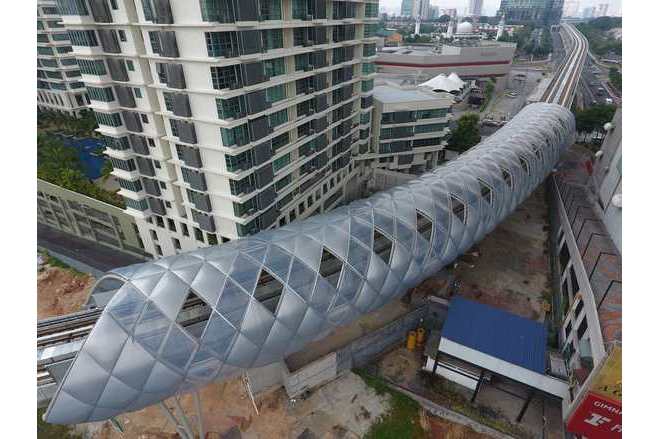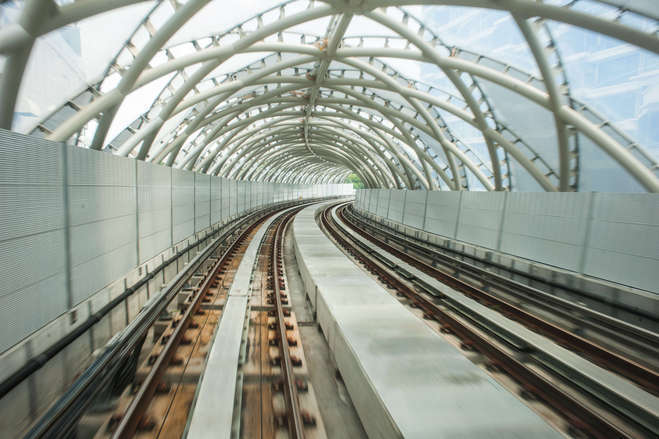Tunnel in the air for Light Rail Train
General information
-
Location address
Kuala Lumpur
-
Location country
Malaysia
-
Year of construction
2016
-
Name of the client/building owner
Prasarana Rail and Infrastructure Projects
-
Function of building
Vehicle services
-
Degree of enclosure
Hybrid structure
-
Type of application of the membrane
covering
-
Primary function of the tensile structure
- Space defining elements
Description
The construction of the elevated railway relieves the traffic at ground level in the same way as underground railways, but is considerably less expensive to build. At the narrowest point of the most recent development stage, the distances between the track and the nearest house and hotel are less than three metres. That leads not only to enormous noise stress for the residents. The train passengers also had a direct view into the homes and hotel rooms.
Therefore, "Prasarana Rail and Infrastructure Projects", who operates the line, decided to equip the narrow point with noise protection elements and to erect a "tunnel in the air" as a privacy shield.
Complex shaping with 363 individual film cushions
Architen Landrell of Chepstow in the UK, one of the leading companies for the use of membranes and films in architecture, was responsible for the implementation. The challenge in Malaysia was the curved route of the track and the tight space between the buildings. The company constructed the air tunnel from 363 steel frames, each one holding a pneumatically inflated cushion made of ETFE film. The frames Architen supplied where aluminium, which fixed to the primary steel tunnel structure. This The cushions are a mixture of clear and printed ETFE film with a heavy silver frit to produce a pattern across the cladding. The tunnel has a complex three-dimensional form. None of the 363 film cushions are identical.
The company developed special software to master this complexity (individual analysis and patterning). The tunnel, which is formed by a lattice of complex steelwork, supports acoustic panels alongside the track in order to give a level of absorption and the ETFE cushion give partial visual obscurity from the railway line to the hotel/apartment. In addition,
the tunnel provides a stunning architectural feature which can be viewed from the ground and runs alongside one of the major trunk road into the city.
The films for the roughly 2.500m² of cushion surface were extruded by Nowofol Kunststoffprodukte GmbH & Co. KG from the highperformance material 3M Dyneon ETFE. The company produces the NOWOFLON® ET 6235Z films in thicknesses between 80 and 400microns, both transparent and in virtually all RAL colours, as well as in an infrared-absorbing version.
Transparent and silver-coloured films were installed in the air tunnel. Moreover, several empty frames allow for pressure compensation when trains pass through.
Description of the environmental conditions
Every few minutes the driverless Kelana Jaya Light Rail Train (LRT) on an elevated railway squeezes its way through the sea of houses in the conurbation of Kuala Lumpur, the capital city of Malaysia. At the narrowest point the track runs less than three metres away from a residential building and a hotel. To protect the residents from the high noise stress, Malaysia's first "tunnel in the air" has been built. It encloses a curved section of the track with 363 film cushions, which are made from the high-performance 3M Dyneon Fluoroplastic ETFE.
Material of the cover
-
Cable-net/Fabric/Hybrid/Foil
Foil
-
Type (code)
NOWOFLON® ET 6235Z
-
Material Fabric/Foil
Nowoflon
Main dimensions and form
-
Covered surface (m2)
2500
Duration of use
-
Temporary or permanent structure
Permanent
Involved companies
-
Engineers
ARCHITEN LANDRELL
-
Contractors
ARCHITEN LANDRELL
-
Suppliers
NOWOFOL
Editor
-
Editor
Evi Corne




